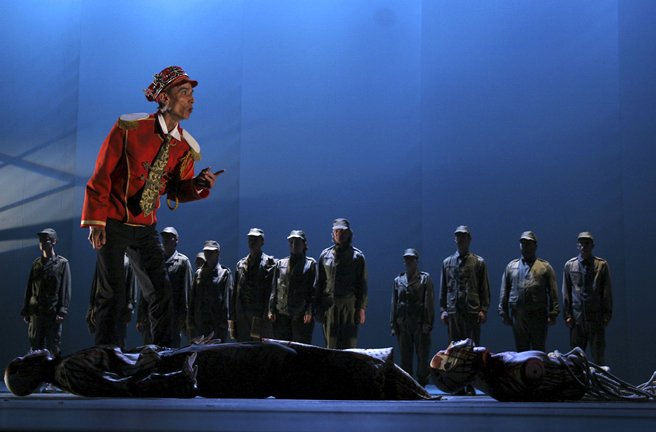We should overcome this willingness to do things in unison. Singing together, humming the same old tunes together, that doesn't make a community.
Howard Barker
Christian Esnay is of that generation of theatre directors to which Odéon-Théâtre de l'Europe has opened itself for the past two seasons. Like Jean-François Sivadier, like Eric Louis and Yann-Noël Collin, he is a former member of the T'chan'G group founded by Didier-Georges Gabily. And like them he prefers theatre which takes the time to construct questioning together with its public. His idea of a "Barker diptych" goes back some time. It follows a five-play theatrical cycle, ironically titled "Reason Governs the World," which deals with the horrors of History. The cycle already included a first version of The Europeans. This revival, associated with the creation of Scenes from an Execution, aims at bringing out the way Barker mocks the oh, so proper construction of Europe, so preoccupied with giving itself a flattering image, sweeping any violence and any appearance of conflict (especially religious conflict) under the rug. And besides, just what is, exactly, a European? "I feel most powerfully what it is to be a European - this broad-mindedness of ideas, this obsession with human form," the playwright confided in 2004, "and I most firmly situate myself in these traditions while all the while being conscious of the need to turn them upside down, to interrogate them. It's extraordinary, in my view, that passions that are so diverse find their origins in the same culture - Bosch and Rembrandt, for instance, or Céline and Thomas Mann in literature. But I find in myself these same types of contradictions, and I don't try to resolve them." Actually, far from reconciling them Barker exacerbates them: if there is such a thing as a "European identity," it could only be a result of the shock of such contradictions, and it could thus only be conceivable in the plural. The twelve scenes in "The Europeans" are situated in the liberated Austria of just after the Battle of Vienna (1683). The post-war chaos throws all moral certitude into crisis. Fiction here is composed of putting on problematic hold the notion of humanity itself. The prevailing horror is the setting for the suffering of Katrin, "wounded citizen" and raped woman, "a howling object on display in the Museum of Reconciliation." All around her more than thirty persons grope through the convulsions of the time. Starhemberg, a national hero and the Saviour of Vienna, moves around from the heights of Empire down to its lower depths; a priest wants to become a bishop and kills his mother because "without knowing what cruelty is, how could I recognize pity?" he says. Katrin ends up giving birth to a child whose ultimate fate hangs by just one thread among others in the heart of the furious labyrinth that each member of the audience has to appropriate for himself or herself.
Cast
by HOWARD BARKER
directed by CHRISTIAN ESNAY
French translation : Mike Sens
Set design : François Mercier
Lights : Bruno Goubert
Costumes : Rose Mary d’Orros
With Ulla Baugué, Olivier Bouana, Belaïd Boudellal, Marie Cariès, Stefan Delon, Gérard Dumesnil, Éric Laguigné, Jacques Merle, Rose Mary d'Orros, Laurent Pigeonnat, Nathalie Vidal, Thierry Vu Huu
Length : 2 hours 10 minutes
production
La Comédie de Clermont-Ferrand
La Comédie de Caen de Normandie
Les Géotrupes
Created October, 5th, 2002 at the Comédie de Clermont-Ferrand
,


